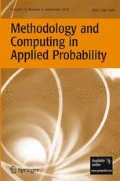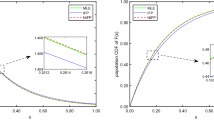Abstract
This paper studies the competing system between two groups of individuals, each of them follows multivariate frailty models. We investigate the distribution of the number of individuals in one group to survive some failure in the other group and how the frailty vector of each group has an impact on the distribution by using stochastic comparisons. Applications in candidates selection by ranking and engineering reliability are presented as well.
Similar content being viewed by others
References
Adler I, Ahn H, Karp RM, Ross SM (2005) A probability model for the survivability of cells. J Appl Probab 42:919–931
Aven T (1990) Availability formulae for standby systems of similar units that are preventively maintained. IEEE Trans Reliab 30:603–606
Belzunce F, Mercader J, Ruiz J, Spizzichino F (2009) Stochastic comparisons of multivariate mixture models. J Multivar Anal 100:1657–1669
Belzunce F, Semeraro P (2004) Preservation of positive and negative orthant dependence concepts under mixtures and applications. J Appl Probab 41:961–974
Birolini A (1994) Quality and reliability of technical systems. Springer, New York
Cha JH, Mi J, Yun WY (2008) Modeling a general standby system and evaluation of its perfomance. Appl Stoch Models Business Industry 24:159–169
Cole NS (1973) Bias in selection. J Educ Meas 10:237–255
Hougaard P (2000) Analysis of multivariate survival data. Springer, New York
Høyland A, Rausand M (1994) System reliability theory. Wiley, New York
Karlin S, Rinott Y (1980) Classes of orderings of measures and related correlation inequalities. I. Multivariate totally positive distributions. J Multivar Anal 10:467–498
Khaledi BE, Kochar S (2001) Dependence properties of multivariate mixture distribution and their applications. Ann Inst Stat Math 53:620–630
Kochar SC, Mukerjee H, Samaniego FJ (1999) The ‘signature’ of coherent system and its application to comparison among systems. Nav Res Logist 46:507–523
Li X, Hu X (2008) Some new stochastic comparisons for redundancy allocations in series and parallel systems. Stat Probab Lett 78:3383–3394
Li X, Ling X, Li P (2009a) A new stochastic order based upon Laplace transform with applications. J Stat Plan Inference 139:2624–2630
Li X, Parker P, Xu S (2009b) A probabilistic characterization of a fault-tolerant gossiping algorithm. J Syst Sci Complex 22:88–108
Li X, Yan R, Zuo M (2009c) Evaluating a warm standby system with components having proportional hazard rates. Oper Res Lett 37:56–60
Li X, Parker P, Xu S (2011) A stochastic model for quantitative security analysis of networked systems. IEEE Transactions on Dependable and Secure Computing. doi:10.1109/TDSC.2008.75
Ma C (1997) A note on stochastic ordering of order statistics. J Appl Probab 34:785–789
Mi J (1999) Optimal active redundancy allocation in k-out-of-n system. J Appl Probab 36:927–933
Mi J, Shaked M (2002) Stochastic dominance of random variables implies the dominance of their order statistics. J Indian Stat Assoc 40:161–168
Misra N, Gupta N, Gupta RD (2009) Stochastic comparisons of multivariate frailty models. J Stat Plan Inference 139:2084–2090
Mulero J, Pellerey F, Rodríguez-Griñolo R (2010) Negative aging and stochastic comparisons of residual lifetimes in multivariate frailty models. J Stat Plan Inference 140:1594–1600
Nanda A, Shaked M (2001) The hazard rate and the reversed hazard rate orders, with applications to order statistics. Ann Inst Stat Math 53:853–864
Navarro J, Samaniego FJ, Balakrishnan N, Bhattacharya D (2008) On the application and extension of system signaturers in engineering reliability. Nav Res Logist 55:313–327
Olkin I, Stephans MA (1993) On making the shortlist for the selection of candidates. Int Stat Rev 61:477–486
Samaniego FJ (2007) System signatures and their applications in engineering reliability. In: International series on operation research and management science, vol 110. Springer, New York
Shaked M, Shanthikumar JG (2007) Stochastic orders. Springer, New York
Sherbrooke CC (2004) Optimal inventory modelling of systems: multi-echelon techniques. Springer, New York
Singh H, Singh RS (1997) Optimal allocation of resources to nodes of series systems with respect to failure-rate ordering. Nav Res Logist 44:147–152
Thorndike RL (1971) Concepts of culture-fairness. J Educ Meas 8:63–70
Valdés JE, Zequeira RI (2006) On the optimal allocation of two active redundancies in a two-component series system. Oper Res Lett 34:49–52
Xu M, Li X (2008) Negative dependence in frailty models. J Stat Plan Inferences 138:1433–1441
Yao DD, Zheng S (2002) Dynamic control of qquality in production-inventory systems. Springer, New York
Yashin AI, Iachine IA (1995) Genetic analysis of durations: correlated frailty model applied to survival of Danish twins. Genet Epidemiol 12:529–538
Yashin AI, Iachine IA (1997) How frailty models can be used for evaluating longevity limits: taking advantage of an interdisciplinary approach. Demography 34:31–48
Yashin AI, Vaupel JW, Iachine IA (1995) Correlated individual frailty: an advantageous approach to survival analysis of bivariate data. Math Popul Stud 5:145–159
Author information
Authors and Affiliations
Corresponding author
Additional information
Supported by National Natural Science Foundation of China (10771090).
Rights and permissions
About this article
Cite this article
Li, X., Da, G. & Zhao, P. Competing Between Two Groups of Individuals Following Frailty Models. Methodol Comput Appl Probab 14, 1033–1051 (2012). https://doi.org/10.1007/s11009-011-9218-y
Received:
Revised:
Accepted:
Published:
Issue Date:
DOI: https://doi.org/10.1007/s11009-011-9218-y



